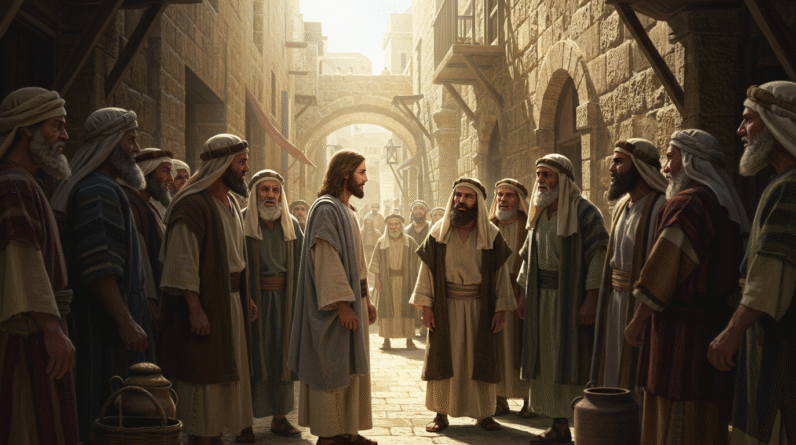Explore the legacy of Herod the Great in Matthew’s Gospel. Delve into a tale of power, paranoia, and cruelty, where architecture tried to overshadow tyranny.
Herod the Great: A Narrative of Fear and Cruelty from Matthew’s Gospel
The world is filled with stories of rulers whose legacies are built on fear and tyranny. One such figure, whose name has become synonymous with cruelty, is Herod the Great. Although he was a master builder and a political genius, his reign is often overshadowed by the darker aspects of his character. Nowhere is this more poignantly captured than in the narrative found in the Gospel of Matthew, a story that still resonates as a cautionary tale of power gone awry.
The Infamous Herod: A Brief Introduction
When you think of Herod the Great, chances are you envision a ruler whose deeds were cloaked in fear and infamy. His life and legacy aren’t just historical footnotes; rather, they hold lessons that withstand the passage of time. Known for his architectural wonders and ruthless governance, Herod was not just a footnote in the ancient chronology but a vivid character in the Biblical narrative, specifically in the Gospel of Matthew.
📖 Key Verse or Passage
To truly grasp Herod’s notoriety, we look to the Bible, starting with a crucial chapter: Matthew 2:1-18. These verses lay claim to the birth of Jesus and the subsequent events orchestrated by Herod in his desperate attempt to hold onto power.

A Self-Made King: The Ascent of Herod
Herod’s rise to power wasn’t by mere chance; it was a calculated journey reflective of his ambition. Born around 72 BCE, Herod was of Idumean descent. With political savvy, he maneuvered through the ranks, gaining the Roman Senate’s favor and eventually being declared King of Judea. You might wonder how someone like Herod managed such a feat.
Herod’s keen political acumen and willingness to form strategic alliances paved his way to the throne. Employing calculated diplomacy, he swayed important figures in Rome, including Mark Antony. Additionally, his proficiency in quelling internal strife in Judea made him indispensable to Roman authorities, who prized stability in their provinces above all. This ambition and skill might seem admirable at a glance, but as you’ll see, they were part and parcel of the cruelty and paranoia that defined his reign.
Paranoia and Power: Herod’s Reign of Fear
While Herod’s ascent is a testament to his political might, it is his paranoia that often overshadows his achievements. You might find it fascinating that this king, despite being powerful, was perpetually insecure. His reign was marked by a series of violent acts born out of his relentless fear of losing power.
The Slaughter of the Innocents
One of the most chilling accounts of Herod’s cruelty is the Massacre of the Innocents, documented in Matthew 2:16-18. This event is not merely a gruesome tale but a reflection of Herod’s state of mind. The Magi had informed him of a new “King of the Jews” born in Bethlehem. Herod, petrified of losing his throne, ordered the killing of all male infants under two years in a bid to eliminate this potential rival.
This action wasn’t just an act of political expediency but a demonstration of paranoia at its zenith. These verses highlight Herod’s descent into tyranny and serve as a somber reminder of the extreme measures a leader consumed by fear might resort to.
The Legacy of Herod: Builder and Tyrant
Despite his notoriety for violence and paranoia, Herod’s reign also left a visible mark on the landscape of Judea and beyond. His architectural projects were grand and opulent, designed to immortalize his legacy. For you, these structures might symbolize both the peak of Herod’s vision and the depth of his insecurity.
Architectural Marvels
- The Second Temple in Jerusalem: Possibly Herod’s most famous project, the refurbishment of the Temple is a testimony to his ambition to leave a lasting legacy.
- The Fortress at Masada: This represents not only his acute awareness of military strategy but also his enduring fear of rebellion.
- The Port City of Caesarea: Named in honor of Caesar Augustus, this city showcased Herod’s flair for integration into the Roman world.
While these achievements may seem detached from his cruel acts, they are two sides of the same coin: a ruler who sought to overshadow his cruelty with grandiosity.
Conclusion: The Cautionary Tale of Herod
Herod the Great remains a complex figure whose shadowy reign mirrors many themes that resonate deeply within you – fear, power, and the essence of human ambition. The Gospel of Matthew offers you a narrative where historical events and moral lessons converge, inviting reflection on what it means to lead with integrity—or without it.
Reflect and Engage
What are the echoes of Herod’s story in today’s world? As you ponder this, consider how power can be wielded responsibly and how history warns us against the cycle of fear and cruelty. History’s pages remind you that in leadership, character is as crucial as competence.

🔍 Explore More Bible Insights:
✅ 1. Serving God by Serving Others
Tone: Practical, inspirational, servant-hearted
🔹 “Live Out Your Faith with These Reads”
✅ 2. The Prayer of Jabez – 1 Chronicles 4:10
Tone: Encouraging, bold faith, personal growth
🔹 “Ask Boldly, Live Fully – Keep Reading”
✅ 3. The Promise of Eternal Life – 1 John 2:25
Tone: Reassuring, hope-filled, theological
🔹 “Secure in Christ – Explore More”
✅ 4. Lessons from the Battle of Jericho – Joshua 6
Tone: Obedience, victory through faith, historical insight
🔹 “Victory Through Faith – Read Next”
As a ClickBank Affiliate, I earn from qualifying purchases.
Acknowledgment: All Bible verses referenced in this article were accessed via Bible Gateway (or Bible Hub).
“Want to explore more? Check out our latest post on Why Jesus? and discover the life-changing truth of the Gospel!”



